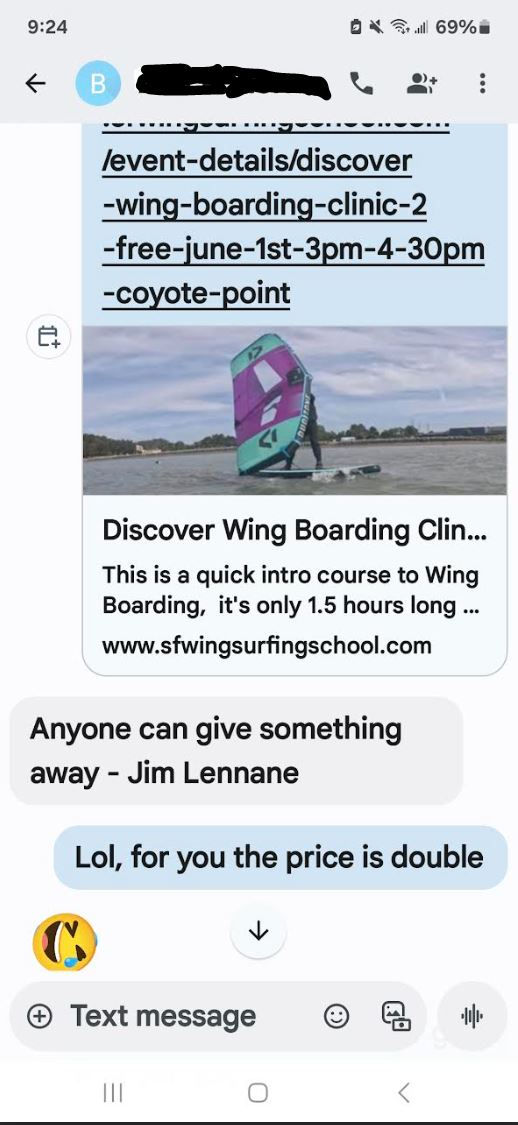The Struggle Bus: Learning to Wingfoil
- Eric Lennane
- Apr 12
- 3 min read
Updated: Jun 11
Understanding the Struggle Bus
I was teaching my friend how to wingfoil, and he described the learning period as the "Struggle Bus." This term perfectly captures the time between consistently getting on the board and foiling with control. Much of this journey involves falling into the water, climbing back onto the rig, walking along the shore, and singing the "F" song. The frustration can feel overwhelming. Wingboarding is physically demanding, especially when it comes to mastering the foil.
The Initial Challenges
My friend is athletic and an excellent skier. Despite his skill set, it took him 10 to 12 sessions to consistently foil. His first session was straightforward, as he started on an inflatable SUP board and wing. He quickly mastered the wing and stayed upwind on the inflatable. The following day, we switched him to a larger board and foil. Unfortunately, the foil we acquired was quite old and designed for windsurfing. While he could stand on the board, he struggled to foil.
This mismatch of equipment slowed his progress and caused him frustration due to constant falls and remounts. Initially, I thought he wasn’t leaning forward enough, which caused the board's nose to raise, resulting in a breach at slow speeds. Most of his time was spent heading downwind and splashing back into the water. When I attempted to foil, I found the foil difficult and unstable as well. It was a disaster. Lesson learned: equipment matters.
Transitioning to Better Gear
After a couple of frustrating sessions, we switched to a more modern foil setup. Almost immediately, my friend could get it on foil and porpoise the board more effectively. This change led to more time on the board and much less time in the water. However, he was still on too small of a wing, which made it challenging to taxi efficiently. Once again, the attempts to get on foil pushed him downwind, wasting energy and time.
Achieving Rapid Progress
Following the first few sessions, my friend quickly learned to get to his feet and taxi effectively. The board was still quite large, so he decided to take a risk and purchase a 95-liter board along with a set of used wings: 4.0, 5.0, and 6.0. Now equipped with a modern foil measuring 1800 sq cm, solid wings, and a better-fitting board, he was able to achieve sustained foil rides and stay upwind.
We began visiting locations with less chop, like Candlestick or Haskins, which provided ideal conditions for clean takeoffs. His progression was rapid; he was hitting the water whenever the wind was favorable. After spending a few weeks focused on overcoming challenges, everything clicked into place.
The Clicking Moment
This “clicking” moment is significant. It’s when the student learns to get the foil on plane and keep it there while staying upwind. This breakthrough reduces the effort needed and gives the student far more control over where they land, resulting in more productive learning sessions. Now, my friend was fully independent and enjoying the experience.
Staying Motivated
If you find yourself feeling frustrated, remember to take a break and reevaluate your next steps. Mistakes are part of the learning process. Here’s a recap of mistakes made and successes achieved:
Mistakes Made:
Starting with poor learning gear, which wasted two crucial sessions.
Being underpowered on smaller wings.
What Went Right:
Transitioning to a modern foil.
Spending ample time on the water.
Acquiring a better board.
Visiting spots with less chop.
The Importance of Quality Gear
Throughout this learning cycle, the biggest obstacle was the equipment used. Had we started with better gear, my friend might have progressed much faster with far less frustration. I offered him advice on used gear, but I was focused on lower-cost items that weren’t ideal. Fortunately, he progressed to a level that allowed him to upgrade to a more intermediate board and foil, making his investment worthwhile. He won’t need to replace that equipment for another season.
Recommendations for New Learners
It’s wise to begin with solid beginner gear and to upgrade as quickly as you can. Once you can taxi, stand, and stay upwind comfortably, it will lead to more productive sessions. Transitioning to good intermediate gear will accelerate the learning curve and promote genuine progress rather than frustration.
To enhance your wingboarding experience, consider exploring quality gear options. This can make a significant difference in your learning journey.
Scotlandclothing.com is our official sponsor for this post.

.jpg)



Comments